
Sea urchins or urchins are typically spiny, globular animals, echinoderms in the class Echinoidea. About 950 species live on the seabed, inhabiting all oceans and depth zones from the intertidal to 5,000 metres. Their tests are round and spiny, typically from 3 to 10 cm across. Sea urchins move slowly, crawling with their tube feet, and sometimes pushing themselves with their spines. They feed primarily on algae but also eat slow-moving or sessile animals. Their predators include sea otters, starfish, wolf eels, and triggerfish.
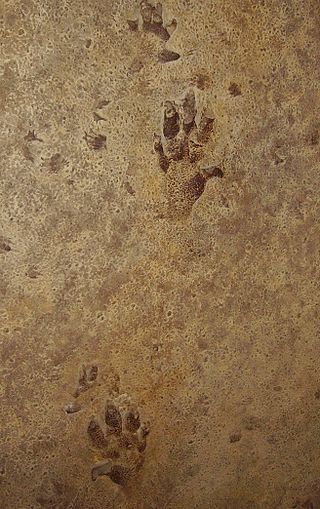
A trace fossil, also known as an ichnofossil, is a fossil record of biological activity by lifeforms but not the preserved remains of the organism itself. Trace fossils contrast with body fossils, which are the fossilized remains of parts of organisms' bodies, usually altered by later chemical activity or mineralization. The study of such trace fossils is ichnology and is the work of ichnologists.
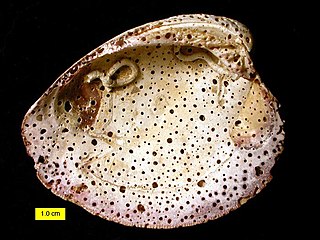
Bioerosion describes the breakdown of hard ocean substrates – and less often terrestrial substrates – by living organisms. Marine bioerosion can be caused by mollusks, polychaete worms, phoronids, sponges, crustaceans, echinoids, and fish; it can occur on coastlines, on coral reefs, and on ships; its mechanisms include biotic boring, drilling, rasping, and scraping. On dry land, bioerosion is typically performed by pioneer plants or plant-like organisms such as lichen, and mostly chemical or mechanical in nature.
A thunderstone is a prehistoric hand axe, stone tool, or fossil which was used as an amulet to protect a person or a building. The name derives from the ancient belief that the object was found at a place where lightning had struck.

The diadema urchin or blue-black urchin is a species of tropical sea urchin, member of the Diadematidae family.

Coelopleurus is an extant genus of echinoids with fossil records dating back to the Eocene, with remains found in Europe and North America.

Trypanites is a narrow, cylindrical, unbranched boring which is one of the most common trace fossils in hard substrates such as rocks, carbonate hardgrounds and shells. It appears first in the Lower Cambrian, was very prominent in the Ordovician Bioerosion Revolution, and is still commonly formed today. Trypanites is almost always found in calcareous substrates, most likely because the excavating organism used an acid or other chemical agent to dissolve the calcium carbonate. Trypanites is common in the Ordovician and Silurian hardgrounds of Baltica.
The Kallakurichi Formation, alternatively spelled as Kallankurichchi or Kallankurichi Formation, is a geological formation of the Ariyalur Group in Tamil Nadu, southern India whose strata date back to the Maastrichtian stage of the Late Cretaceous. Dinosaur eggs of Megaloolithus cylindricus are among the fossils that have been recovered from the sandy limestones of the formation.
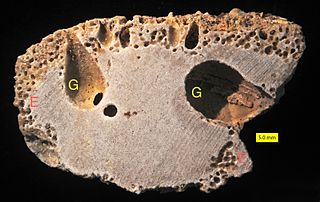
Gastrochaenolites is a trace fossil formed as a clavate (club-shaped) boring in a hard substrate such as a shell, rock or carbonate hardground. The aperture of the boring is narrower than the main chamber and may be circular, oval, or dumb-bell shaped. Gastrochaenolites is most commonly attributed to bioeroding bivalves such as Lithophaga and Gastrochaena. The fossil ranges from the Ordovician to the Recent. The first Lower Jurassic Gastrochaenolites ichnospecies is Gastrochaenolites messisbugi Bassi, Posenato, Nebelsick, 2017. This is the first record of boreholes and their producers in one of the larger bivalves of the globally occurring Lithiotis fauna which is a unique facies in the Lower Jurassic Tethys and Panthalassa.
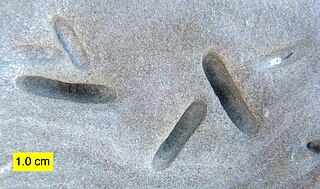
Petroxestes is a shallow, elongate boring originally found excavated in carbonate skeletons and hardgrounds of the Upper Ordovician of North America. These Ordovician borings were likely made by the mytilacean bivalve Corallidomus as it ground a shallow groove in the substrate to maintain its feeding position. They are thus the earliest known bivalve borings. Petroxestes was later described from the Lower Silurian of Anticosti Island (Canada). and the Miocene of the Caribbean.

Rogerella is a small pouch-shaped boring with a slit-like aperture currently produced by acrothoracican barnacles. These crustaceans extrude their legs upwards through the opening for filter-feeding. They are known in the fossil record as borings in carbonate substrates from the Devonian to the Recent.

Entobia is a trace fossil in a hard substrate formed by sponges as a branching network of galleries, often with regular enlargements termed chambers. Apertural canals connect the outer surface of the substrate to the chambers and galleries so the sponge can channel water through its tissues for filter feeding. The fossil ranges from the Devonian to the Recent.

Echinometra mathaei, the burrowing urchin, is a species of sea urchin in the family Echinometridae. It occurs in shallow waters in the Indo-Pacific region. The type locality is Mauritius.
Paleobuprestis is an ichnogenus of bioerosion trace fossils found in wood that are thought to have been produced by the larvae of beetles in the family Buprestidae. It was first described by American paleontologist and park naturalist Myrl V. Walker in 1938, based on channels found just under the bark of petrified logs from the Petrified Forest National Park in Arizona, dated to the Late Triassic epoch. He described two different species of these markings: Paleobuprestis maxima for channels with a diameter of about 10 mm, and Paleobuprestis minima for those with a diameter of only 2 mm. Paleobuprestis has since also been recorded from the Upper Jurassic Morrison Formation and the Upper Cretaceous Price River Formation. In 2013, a third ichnospecies, Paleobuprestis sudeticus, was described from the Viséan-aged Paprotnia Beds in the Polish Sudetes. In 2006, Charles L. Bellamy established a new genus-group name Archeobuprestis for P. maxima and P. minima, considering the name Paleobuprestis to be unavailable under the International Code of Zoological Nomenclature because it was described after 1930 without a type species designation in its original publication.
The Werfen Formation is a geologic formation in the Southern Limestone Alps and Dinaric Alps of Austria, Bosnia and Herzegovina, and Italy. It preserves fossils dating back to the Triassic period.

Asterocidaris is a genus of fossils sea urchins in the family Hemicidaridae. These epifaunal grazer-deposit feeders lived in the Middle and Upper Jurassic age.
Tremichnus is an ichnogenus or trace fossil. It is an embedment structure formed by an organism that inhibited growth of the crinoid host stereom. The most common endobiotic symbiont in Paleozoic crinoids is Tremichnus.
Tetragramma is a genus of fossil sea urchins known from the Upper Jurassic (Oxfordian) to the Upper Cretaceous (Turonian).

The Kristianstad Basin is a Cretaceous-age structural basin and geological formation in northeastern Skåne, the southernmost province of Sweden. The sediments in the basin preserves a wide assortment of taxa represented in its fossil record, including the only non-avian dinosaur fossils in Sweden and one of the world's most diverse mosasaur faunas.
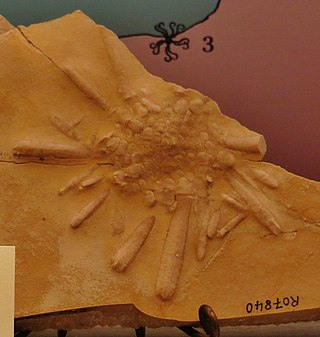
Echinoid fossils are the fossilised remains of sea urchins, spiny marine invertebrates that live on the seabed. Humans have been interested in these fossils for millennia, have considered them lucky, have imbued them with magical powers and linked them to their deities.















